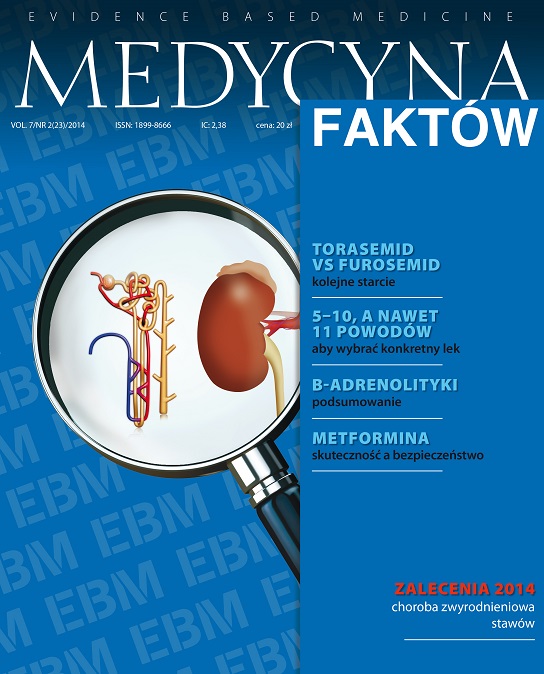Ten reasons why you should use amoxicillin with clavulanic acid Review article
Main Article Content
Abstract
The combination of amoxicillin with clavulanic acid significantly expanded its range of antibacterial activity. The antibiotic may penetrate well distributed to most tissues, allowing its effective use in the treatment of infections. Effective absorption of the substance from the gastrointestinal tract allows easy use in outpatient therapy. Amoxicillin clavulanate is a safe drug with a small organ toxicity, which also allows its use in patients who are pregnant or nursing. The antibiotic may for years successfully used for the eradication of diseases of the upper gastrointestinal tract, which are found in the course of the presence of Helicobacter pylori. This formulation, thanks to their synergistic properties in combination with other antibiotics such as fluoroquinolones or aminoglycosides, significantly increases the effectiveness of antimicrobial activity.
Article Details
Copyright © by Medical Education. All rights reserved.
References
2. Dzierżanowska D., Jurkiewicz D., Zielnik-Jurkiewicz B.: Zakażenia w otolaryngologii. α-medica Press, Bielsko-Biała 2002; 220-226.
3. Yin H., Xiang S., Zheng J. et al.: Induction of holomycin production and complex metabolic changes by the argR mutation in Streptomyces clavuligerus NP1. Appl. Environ. Microbiol. 2012; 78(9): 3431-3441.
4. Kostowski W., Herman Z.S.: Farmakologia. Wyd. III. T. 2. PZWL Warszawa 2010; 309.
5. Dzierżanowska D., Dzierżanowska-Fangrat K.: Przewodnik antybiotykoterapii 2011. α-medica Press, Bielsko-Biała, 2011; 70-71 i 80-82.
6. Holten K.B., Onusko E.M.: Appropriate prescribing of oral beta-lactam antibiotics. Am. Fam. Physician. 2000; 62(3): 611-620.
7. Singh M., Kambalimath D.H., Gupta K.C.: Management of odontogenic space infection with microbiology study. J. Oral and Maxillofac. Surg. 2014; 13(2): 133-139.
8. Smuszkiewicz P., Szałek E., Tomczak H. et al.: Zasady farmakokinetyczno-farmakodynamiczne stosowania antybiotyków u chorych septycznych. Anestezjologia Intensywna Terapia 2007; 39(3): 166-74.
9. Craig WA., Andes D.: Pharmacokinetics and pharmacodynamics of antibiotics in otitis media. Pediatr. Infect. Dis. J. 1996; 15(3): 255-259.
10. American Academy of Pediatrics Subcommittee on Management of Acute Otitis Media: Diagnosis and management of acute otitis media. Pediatrics. 2004; 113(5): 1451-1465.
11. Chu C.H., Wang M.C., Lin L.Y. et al.: High-dose amoxicillin with clavulanate for the treatment of acute otitis media in children. Scientific World Journal 2014; 2014: ID 965096, 6 pages.
12. Alahdab Y.O., Kalayci C.: Helicobacter pylori: Management in 2013. World J. Gastroenterol. 2014; 20(18): 5302-5307.
13. Berrutti M., Astegiano M., Smedile A. et al.: Efficacy of amoxycillin plus clavulanic acid-based triple therapy for Helicobacter pylori eradication: a retrospective study. Panminerva Med. 2010; 52(4): 361-362.
14. Cennamo V., Morace C., Ceroni L., Fabbri C.: On the efficacy of penicillins for Helicobacter pylori eradication. Panminerva Med. 2011; 53(2): 137.
15. Netzer R.O., Zollinger E., Seiler C., Cerny A.: Infective endocarditis: clinical spectrum, presentation and outcome. An analysis of 212 cases
1980-1995. Heart 2000; 84(1): 25-30.
16. Banach M., Ostrowski S., Okoński P.: Infekcyjne zapalenie wsierdzia – aktualny stan wiedzy. Przewodnik Lekarza 2004; 10(7): 80-88.
17. Slavin M.A., Thursky K.A.: Outpatient therapy for fever and neutropenia is safe but implementation is the key. J. Clin. Oncol. 2013; 31(9): 1128-1129.

